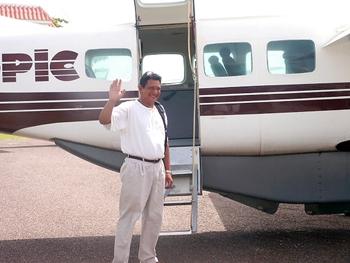 | | Green Reef's Mito Paz returning from trip to Okinawa |
Mito Paz, Executive Director of Green Reef Environmental Institute
in San Pedro, has recently returned from a trip to Okinawa, Japan where
he attended the 10th annual International Symposium on the Reef
sponsored by the International Coral Reef Society and the Japan Coral
Reef Society. Paz and fellow Belizean Melanie McField of the World
Wildlife Fund were among 1,400 people who participated in the five-day
(June 28th - July 2nd, 2004) event, which brought together
international coral reef scientists, researchers, marine park managers,
government agency personnel, and non-governmental organization (NGO)
members from around the world.
Following the symposium, the Green Reef Executive Director took
part in two Coral Reef Monitoring workshops sponsored by Coral Network
(July 3rd) and Reef Check (July 3rd- 7th). The Coral Network "Spot
Check Workshop" involved a standard, simplified method of coral reef
monitoring used by the Ministry of the Environment in Japan. The Reef
Check/SocMon Workshop focused on the method of coral reef monitoring
employed by Global Coral Reef Monitoring Network (GCRMN)/Reef Check.
Training was received through lectures, snorkeling and scuba dive
training.
Mr. Paz explained that "SocMon," is a set of guidelines for
establishing a socio-economic monitoring program at coastal management
sites. It provides a methodology for regularly collecting basic socio-
economic data useful for coastal management at the site level. It also
provides a basis for a regional system by which site level data can
feed into regional and international databases for comparison. "This
method measures the value of the coral reef by introducing the human
factor into the formula. It measures how many people are using the reef
and what they are using it for. It also seeks to estimate how it would
affect people's livelihood if reefs were to disappear twenty years from
now," stated Paz.
Open water training was conducted in the Kerama Islands, one of the
world's most prominent coral reef sites. Unfortunately, two typhoons
located offshore in the Pacific Ocean prevented the group from
conducting any significant amount of water training. According to Mr.
Paz, ocean swells were reportedly 20 feet high at times, so he was only
able to complete one dive, in rainy conditions. He described the
Japanese corals as very different from the ones in Belize. "Some of the
reefs there have 100% coverage. Like Belize, the coral bleaching of
1998 hit them hard and killed approximately 50% of their corals. Their
recovery was much quicker though, due to a type of plate-like coral
that grows very quickly, compared to our hard corals," Mr. Paz
explained. Participants used the extra time not spent in the water
to "brainstorm" ideas regarding the information and methods provided in
the Reef Check manual.
The training workshops introduced two simple ways to monitor coral
reefs so that nations' economies can continue to rely on them as a
source of income. By monitoring coral reefs, data is compiled that will
hopefully be used to improve coral reef preservation. Following the
training, participants were able to choose which method they thought
would be more suitable for the local conditions and which would
hopefully spread the use of coral reef monitoring throughout Japan.
Reef Check, who funded Green Reef's participation in Japan, is an
international, non-profit organization dedicated to bringing coral
reefs back to health and keeping them that way. Reef Check's mission is
to train teams of volunteers to monitor the status of the reefs around
the world. The information gathered is used to make decisions on how to
preserve and wisely use reefs. Reef Check has survey teams in more than
50 countries. These groups look after their local reefs and work with
individual governments and businesses to develop ecologically sound and
economically sustainable solutions for the future of the Earth. The
site's geographic coordinates and the coral reef survey data collected
is then processed and thoroughly examined to determine whether or not
the reef is healthy. The organisms counted include invertebrates, fish,
nutrient indicator algae (NIA) and recently killed corals (defined as
killed within the past one year as indicated by algal growth). A low
number of certain organisms may indicate activities such as over
fishing, blast fishing, poison fishing, aquarium fishing, nutrient
pollution and curio (gift shop) collection.
During his trip to Japan, the Green Reef President also learned
that the Reef Check database would soon be online so that everyone will
be able to check on the health of the reefs in their region or compare
them to others around the world. Paz told The San Pedro Sun, "This
information will be invaluable when making presentations to regional
stakeholders or government agencies, especially if it helps them to
realize the importance of preserving our coral reefs."
Green Reef was established as a Reef Check regional training center
in November 2003. Reef Check serves as the community-based component of
the Global Coral Reef Monitoring Network (GCRMN) and collaborates on
regular status reports. Reef Check is a member of the International
Coral Reef Initiative (ICRI) and International Coral Reef Action
Network (ICRAN). Reef Check data is provided to Reefbase, the global
database on coral reefs.

|





